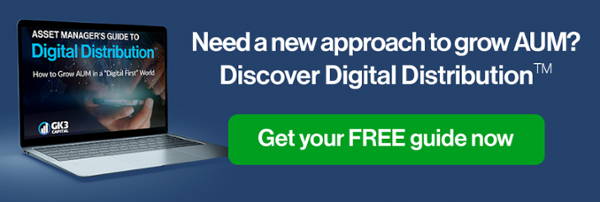
I have spent many of my 17 years in the financial services industry training and coaching salespeople at all levels—from new hires to industry veterans. The one thing that all of us know is that to be effective salespeople we have to be able to build trust with our prospects and clients.
But how do we do that?
And, more importantly, how do we know if we are doing it effectively?
The Trust Equation
--%20The%20Trusted%20Wholesaler%20blog.jpg?width=207&name=The%20Trusted%20Advisor%20(option%202)--%20The%20Trusted%20Wholesaler%20blog.jpg) I started sharing the Trust Equation from David Maister's book The Trusted Advisor a decade ago when I was helping to lead the training and development effort for Alliance Bernstein's Capital Markets group. The terminology and the way I teach it has evolved over the years to apply it to distribution, but what has remained consistent is that there are only two outcomes possible after every client or prospect interaction. You have either built more trust than you previously had with that person OR you took a step back in the trust continuum. After every interaction, you must be prepared to answer "Which of these outcomes did I achieve?"
I started sharing the Trust Equation from David Maister's book The Trusted Advisor a decade ago when I was helping to lead the training and development effort for Alliance Bernstein's Capital Markets group. The terminology and the way I teach it has evolved over the years to apply it to distribution, but what has remained consistent is that there are only two outcomes possible after every client or prospect interaction. You have either built more trust than you previously had with that person OR you took a step back in the trust continuum. After every interaction, you must be prepared to answer "Which of these outcomes did I achieve?"
In order to answer this, you need to be aware of where you are in the trust development process with a particular prospect/client. Simply put, the greater the trust is between you and your client, the more comfortable and appropriate it is for the "ask" to be greater. For example, when you are calling a prospect for the first time, you are generally asking if they "have a few minutes?" Your ask is equal to the amount of trust that you have developed up to that point....not much. If you want to ask your client or prospect to allocate 5% of their client assets to your company's investment product, you will have to have built up a tremendous amount of trust before they are likely to do so.
So, how do you do that and how do you measure it?
Introducing the Trust Equation:
Trust = Credibility x Reliability x Empathy / Self-Orientation
About The Trust Equation
As you can see, this is really just a simple, elementary school math equation with a numerator and a denominator. The same principles apply—high numerator with a low denominator equals a higher result. Said another way, if you want to build more trust with your clients, you need to demonstrate a higher degree of credibility, reliability, and empathy than you do self orientation.
- Credibility
- Reliability
- Empathy
- Self-Orientation
Let's Expand on Each, One at a Time
1. Credibility
- Credibility is the most common goal to achieve as sales professionals
- Content expertise plus presence (how we look, act, react, and talk about our content) can enhance our credibility in a prospect's/client's eyes.
- Accuracy and completeness of information also add credibility for us.
- Credibility does not happen overnight; rather it is established over time.
- Initially, a certain amount of credibility is assumed based upon what firm you work for and what your personal experience is. Additional factors such as what degrees you have, your job title, your years of relative work experience, and whether your firm is a well-known entity or a start-up also play a role.
2. Reliability
- Reliability grows when your clients think you are dependable and can be trusted to behave in consistent ways. It can be demonstrated through repeated experiences maintaining the link between promises and action that a client/prospect experiences from you.
- Clients/prospects judge us on our reliability with due dates and quality levels—on time and measured against what was expected.
- Less formally, a client/prospect will consider how long it takes you to return a phone call, answer an email, whether meetings are cancelled or kept, and whether to-do items are completed.
3. Empathy
While credibility and reliability are expected from sales people, it is empathy that is the most difficult for us to demonstrate, but which yields the greatest impact on our ability to build trust with our clients and prospects. However, not demonstrating empathy is the most common failure among salespeople. Empathy, by definition, is the ability to understand and share the feelings of another. This is often difficult for salespeople because we are thought to be very professional and businesslike and some view empathy as a weakness. This could not be further from the truth.
The very best salespeople demonstrate empathy by actively listening and solving problems for their clients. The following is taken from the center for creative leadership and describes the six steps for active listening.
No. 1: Pay attention. One goal of active listening is to set a comfortable tone and allow time and opportunity for the other person to think and speak. Pay attention to your frame of mind as well as your body language. Be focused on the moment and operate from a place of respect.
No. 2: Withhold judgment. Active listening requires an open mind. As a listener and a leader, you need to be open to new ideas, new perspectives and new possibilities. Even when good listeners have strong views, they suspend judgment, hold their criticism and avoid arguing or selling their point right away.
No. 3: Reflect. Learn to mirror the other person’s information and emotions by paraphrasing key points. Don’t assume that you understand correctly or that the other person knows you’ve heard him. Reflecting is a way to indicate that you and your counterpart are on the same page.
No. 4: Clarify. Don’t be shy to ask questions about any issue that is ambiguous or unclear. Open-ended, clarifying and probing questions are important tools. They draw people out and encourage them to expand their ideas, while inviting reflection and thoughtful response.
No. 5: Summarize. Restating key themes as the conversation proceeds confirms and solidifies your grasp of the other person’s point of view. It also helps both parties to be clear on mutual responsibilities and follow-up. Briefly summarize what you have understood as you listened, and ask the other person to do the same.
No. 6: Share. Active listening is first about understanding the other person, then about being understood. As you gain a clearer understanding of the other person’s perspective, you can then introduce your ideas, feelings and suggestions. You might talk about a similar experience you had or share an idea that was triggered by a comment made previously in the conversation.
4. Self-Orientation
Now remember, in the previous three variables to our equation, (those in the numerator), we wanted to demonstrate a higher, or greater, degree of each. With self orientation, it is the opposite. Our goal should be to demonstrate as little self orientation as possible. Simply put, self-orientation is being more interested in yourself than the client/prospect. And the most egregious form of self-orientation is, of course pure selfishness—being "in it for the money." With that said, self-orientation is about more than being greedy. It is anything that keeps us focused on ourselves rather than our client:
- Selfishness
- Self-consciousness
- A need to appear on top of things
- A desire to look intelligent
- Thinking of our to-do list while in a meeting with our client
- A desire to jump to a solution
- A desire to be right
Here are a few of the ways that you can demonstrate low self-orientation:
- Let the client fill in the empty spaces in the conversation
- Ask the client to talk about the details behind their challenges
- Use open-ended questions
- Focus on defining the problem, not guessing the solution
- Say you don't know when you don't know
- Trusting in our ability to add value after listening, rather than trying to so during listening
How We Use the Trust Equation
As I mentioned earlier, there are only two possible outcomes to any client engagement; you either increase the amount of trust in that relationship, or you decrease it. As you begin to build more trust as a salesperson, you earn the right to ask for mutually beneficial ways to work together. To learn more about the trust equation, check out the book The Trusted Advisor by David H. Maister.
John Gulino is the Founder and CEO of GK3 Capital LLC. Experienced in all facets of distribution including management, direct sales, training, and development, John has been fortunate to represent some of the industry’s most respected and innovative financial institutions and has consulted with many more of the top asset management firms in the industry on how to better align their sales and marketing efforts.


